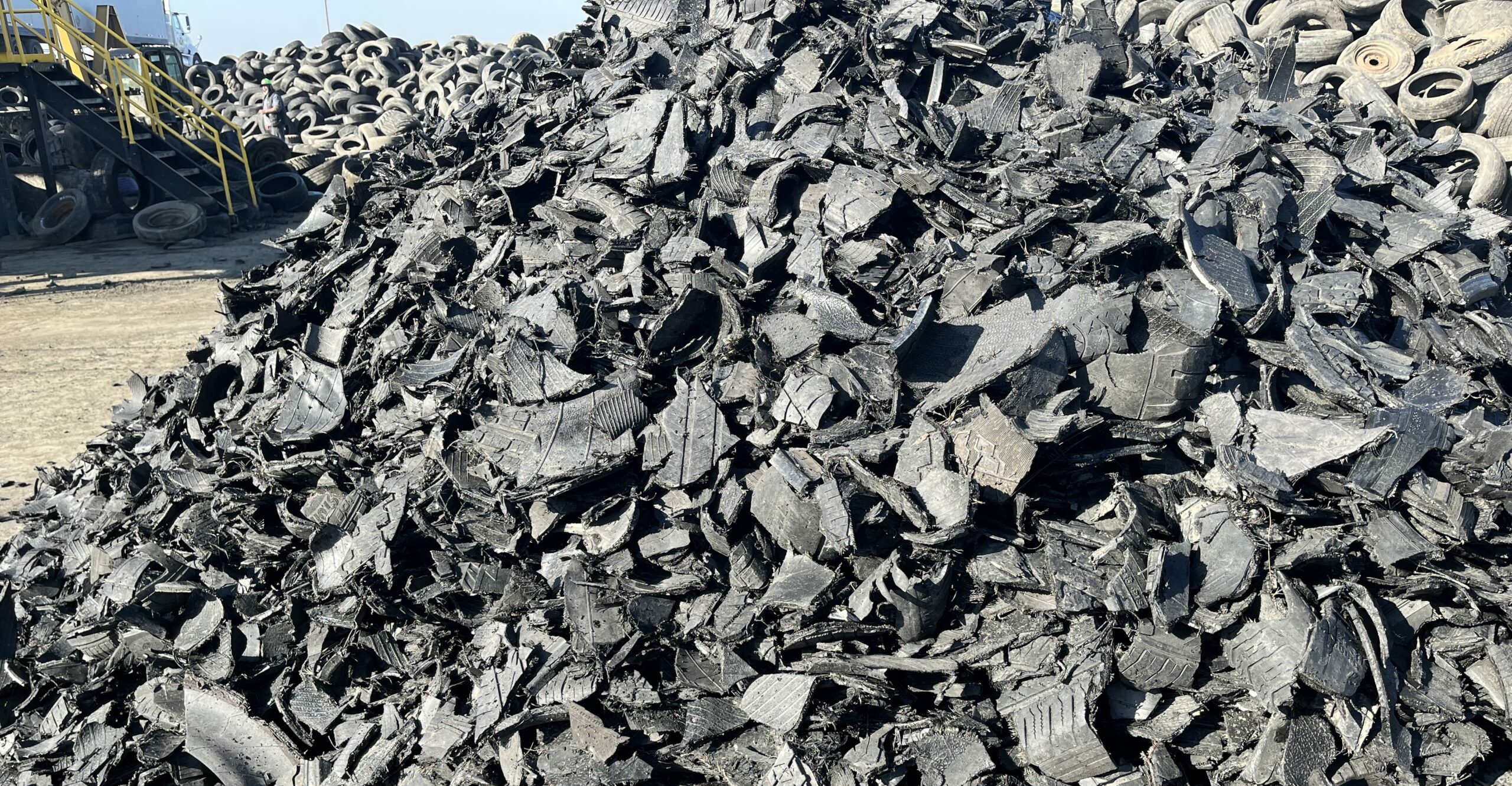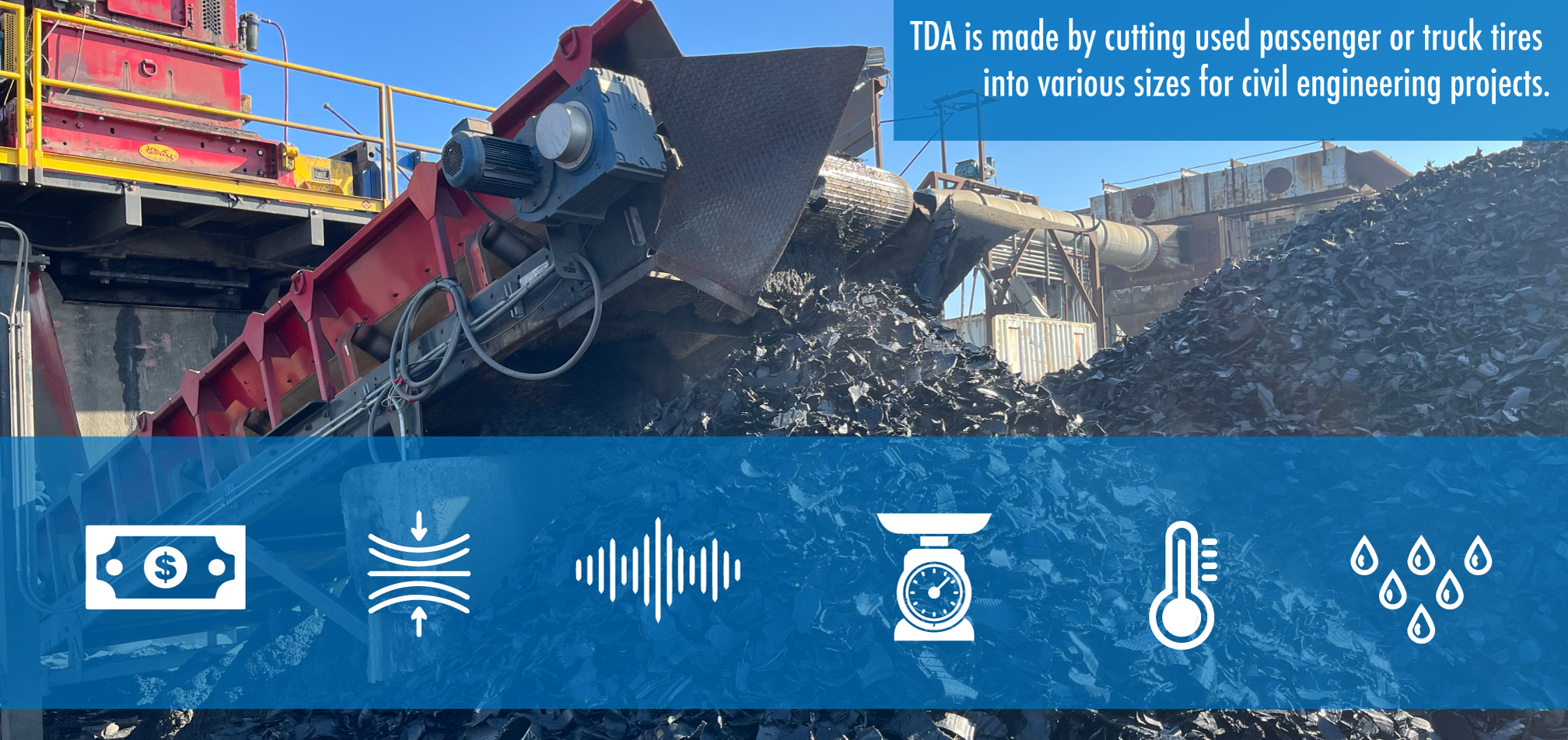Tire-Derived Aggregate (TDA)
California makes more than 51 million waste tires per year that can be easily recycled into new products. In 2021, California recycled 28 million tires instead of burying them in a landfill. Tires can be chipped into smaller pieces of rubber called tire-derived aggregate (TDA) that can be used in civil engineering projects like:
- Lightweight fill behind retaining walls
- Vibration mitigation
- Lightweight fill for road repair and embankment construction
- Permeable drainage material
TDA is safe to use, cost-effective, and a plentiful resource that reduces pollution caused by sourcing raw materials. Recycling tires into new products helps build a circular, reuse economy in California that fights pollution, creates new jobs, and helps communities expand their local infrastructure.
Grant Funds Available to Local Governments for TDA Civil Engineering Projects
CalRecycle has reimbursement grants for using TDA in infrastructure projects.
Recycled Tires Make Superior Engineering Products
Cost Effective
Compressible
Reduces Ground Vibrations
Lighter than Soil
Better Thermal Insulation than Soil
Better Drainage than Gravel
TDA Is a Cost-Effective Solution for Many Engineering Projects
Low-Cost Vibration Mitigation
Long-Term Road Repair
#
Lightweight Fill
Lightweight TDA is ideal to place over poor subgrade material that may consolidate with heavy loading. TDA filled projects require less maintenance and are more cost-effective in both short and long-term.
Heavy loads on road surfaces can compress poor subgrade layers. When those layers settle, the road surface may create bumps. These road sections will need more frequent repairs to maintain their safety.
- TDA has lightweight and free draining characteristics. These characteristics contribute to its cost effectiveness.
- TDA is one third the weight of soil and other similar construction materials and is more cost-effective to deliver.
- TDA is free draining so it can also be used as a replacement material for infiltration systems.
- For the past 25 years CalRecycle has been supporting research of TDA material properties to confirm that TDA is both safe and effective to use in the environment.
- TDA can be produced in 2 different sizes. Type A which is about 2-3 inches in size and Type B which is approximately 8-12 inches in size.
Projects:
Dixon Landing
Confusion Hill
Roadway Repair and Slope Stabilization
When a road landslide or “slip out” occurs, it is often necessary to excavate the sliding road material down to more stable soil and then rebuild the slope and road in compacted layers of soil called lifts. Drainage networks are typically installed so that hydrostatic pressure does not build up behind the fill, causing potential instability.
By using TDA as a lightweight backfill material, less excavation is necessary, and TDA’s free-draining and durable properties allow for a more cost-effective and long-term repair.
CalRecycle has worked with counties across California to repair failing roads using TDA as lightweight fill. More than 3 million tires have been used for road repairs in California.
Mendocino County Landslide Repair
In 2007, CalRecycle and the Mendocino County Department of Transportation repaired a landslide on Marina Drive near Ukiah using TDA from 131,000 waste tires.
Sonoma County Landslide Repairs
In 2008, CalRecycle and Sonoma County Public Works Department repaired two road slide projects at Geysers Road and Sonoma Mountain Road using TDA from 480,000 tires.
Projects:
Geysers Road (Sonoma County) (Slope Stabilization)
Marina Drive (Mendocino County) (Slope Stabilization)
Sonoma Mountain Road (Mendocino County) (Slope Stabilization)
Palomino Road (Santa Barbara County) (Slope Stabilization)
Ortega Ridge Ct. – MSTDA (Santa Barbara County)
Italian Bar Road multiple sites, – MSTDA , Welded Wire Road repair, Gabion Basket Road repair (Tuolumne County)
Yuba County Multiple sites – Road Repairs, Fountain House Road
Lightweight Embankment
An embankment is a compacted material that helps raise the grade of a roadway (or railway) above the level of the existing surrounding ground surface. TDA can be used as a lightweight embankment fill that limits the settling of roadways after construction.
When soil is used over unconsolidated or poor quality soils like silt or clay, the additional weight of the soil can cause settlement over time and potential road surface failures that require ongoing repairs.
TDA is a cost-effective, long-term solution for constructing safe roadways that are less likely to need costly maintenance.
Dixon Landing Interchange Embankment
In 2000, the City of Milpitas constructed an embankment fill for the Dixon Landing Road/Interstate 880 southbound on-ramp using TDA. This completed project resulted in an overall project cost savings by using TDA as the lightweight fill material and by shortening the project timeline by decreasing the surcharge and consolidation time that was required. This project has been in use for 22 years and has continued to perform well, with no repairs or issues.
TDA as Drainage in Landfill Gas Collection Systems
TDA can be used as drainage material in landfill gas and leachate collection and removal systems instead of gravel. TDA is used specifically in collection trenches, for header pipe protection, and in leachate recirculation systems. Both Type A and Type B TDA can be used in these applications.
Retaining Wall Backfill
TDA is a good backfill material to use when designing a retaining wall because it is about 30% lighter than soil, is free draining, and has a high internal angle of friction, which results in significant pressure reduction on the wall.
The California Integrated Waste Management Board (CalRecycle’s predecessor) and CalTrans oversaw two pilot projects in Riverside County to analyze the use of TDA as a lightweight backfill material for a retaining wall. The projects were successful and confirmed that TDA is an effective material to use in this application.
Projects:
Riverside 215/60/91 interchange (retaining wall)
Vibration Mitigation in Rail Transportation
TDA can be used to decrease the ground borne vibration and subsequent noise from trains, which has a positive impact on communities. Traditional methods of reducing rail vibration noise are effective but costly and include rubber ballast mats, special track fasteners, and floating slabs of concrete. When using TDA as a ground borne vibration attenuation method, one foot of Type A TDA is installed and compacted underneath the typical rail section. This has saved rail authorities millions of dollars in California while mitigating vibration from trains through our communities.
Valley Transportation Authority (VTA)
In 2000 CalRecycle partnered with the Valley Transportation Authority (VTA) in San Jose to demonstrate the beneficial use of TDA as a vibration-damping material in its light rail system. The results of this project showed that TDA was a safe and extremely cost-effective technology to dampen ground borne vibration.
As a result, in 2004, the VTA used 1000 tons of TDA in 2,000 feet of light rail section along its Vasona Line expansion, a cost saving of over $1,000,000. Since 2004, TDA has been used by many light rail lines in the nation to mitigate vibrations through communities, including California’s BART and L.A. Metro systems.
Warm Springs and Berryessa BART Extension
Following the VTA project, the Bay Area Rapid Transit (BART) Authority selected TDA as a vibration-damping material for their Warm Springs and Berryessa Extension (WSX) Projects in Fremont to meet Federal Transportation Authority (FTA) vibration mitigation requirements.
Storm Water Infiltration Galleries
TDA is used in LID applications as a replacement for gravel material in storm water Infiltration galleries. Low Impact Development (LID) is a sustainable practice that benefits water supply and contributes to water quality protection. Traditional storm water management practices have been to collect and convey storm water runoff through storm drains, pipes, and other conveyances to a centralized storm water facility.
LID takes a different approach and uses sustainable storm water management practices in the site design to maintain the site’s pre-development runoff rates and volumes.
The goal is to use design techniques that:
- infiltrate,
- filter,
- store,
- evaporate, and
- detain runoff close
Storm water infiltration galleries are one option used in LID.
TDA has many beneficial engineering characteristics that result in being an excellent choice as a drainage material in infiltration gallery applications.
TDA is:
- Lightweight
- Free draining
- High void ratio material
- Durable
- 100% recycled material
Reports and Resources
- Civil Engineering Application of TDA on Dixon Landing Road On-Ramp Project, Highway 880 Milpitas, California
- Marina Drive Slide Repair, Mendocino County, California
- Material Specifications for Use of Type A and Type B Tire-Derived Aggregate in Civil Engineering Applications
- “New asphalt could support a better commute.” San Jose Mercury News, August 14, 2001 (Text-only version) [Copyright © 2001 San Jose Mercury News. All rights reserved. Reproduced with permission.]
- Photo Gallery of Retaining Wall 119 Project, Riverside, California
- “Recycling tires as road fill.” Ukiah Daily Journal, September 7, 2007 (Text-only version). [Reprinted with permission from the Ukiah Daily Journal.]
- Properties of Tire-Derived Aggregate For Civil Engineering Applications
- Badlands Landfill Tire-Derived Aggregate Gas Collection: Pilot Analysis Phase III Report
- TDA Brochure
- TDA Material Specification
Technical Assistance. CalRecycle provides engineering and technical assistance to local jurisdictions for education, design, and construction oversight on TDA projects in California.
For questions, contact TDA@calrecycle.ca.gov
Tire Engineering Research Center at CSU Chico
csuchico.edu/cp2c/terc

For more information, contact TDA@CalRecycle.ca.gov

